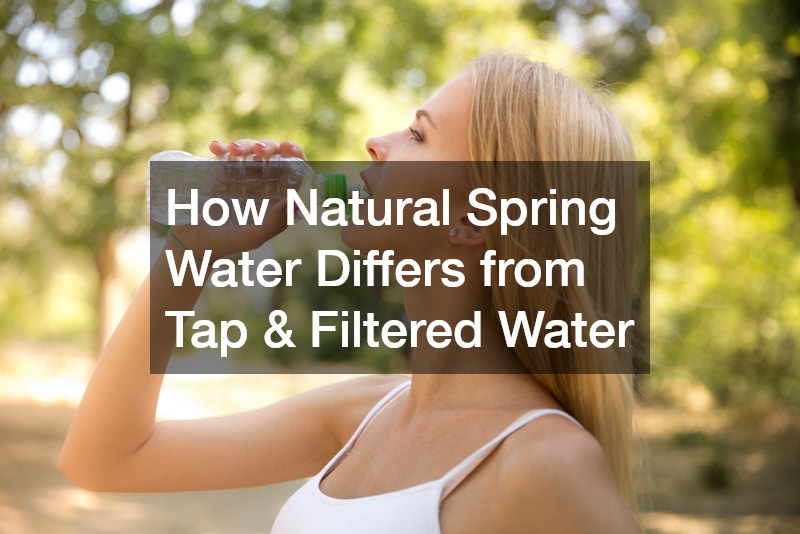Choosing the right type of drinking water has become more than a matter of taste. As Australians become increasingly health-conscious and environmentally aware, the conversation around daily hydration has shifted. While water may seem like a simple choice, not all types are created equal. Among the most common options are tap, filtered and natural spring water. Although they all serve the same basic function, the differences between them are significant — from how they’re sourced to how they taste and impact the environment.
Source & Origin
Tap water is drawn from surface sources such as dams, rivers and reservoirs or from underground bore water. It’s treated and distributed by local councils or utilities to meet national standards.
Filtered water usually starts as tap water, which is then processed through an additional filtration system in a home or business. Filters can vary in complexity, from basic jugs with activated carbon to high-end reverse osmosis systems.
By contrast, one option is collected directly from natural underground springs. This water emerges at the surface or is accessed through boreholes close to its origin point. It’s often bottled with minimal intervention, preserving its original composition.
Treatment Processes & Additives
Tap water undergoes a comprehensive purification process that includes filtration, sedimentation and chemical disinfection. Additives like chlorine or chloramine are commonly used to eliminate harmful microbes. Fluoride is also added in many areas to support dental health, though its use is occasionally debated.
Filtered water seeks to remove many of these chemicals. Depending on the filter type, it can reduce chlorine taste, sediments, heavy metals and even fluoride. However, overly aggressive filtration may also eliminate beneficial minerals unless designed to retain them.
Spring-sourced water is typically treated only to remove debris or potential microbial contaminants. It usually avoids added chemicals, maintaining a more natural taste profile.
Mineral Content & Flavour
Tap water contains varying levels of naturally occurring minerals depending on the source. Fluoride, calcium and magnesium are often present, though levels are regulated and monitored. Additives like chlorine can sometimes impart a chemical aftertaste.
Filtered water can improve taste significantly, especially for those sensitive to chlorine. Still, extensive filtration can strip the water of flavour-enhancing minerals, leaving it with a blander profile.
Spring-derived water often contains a naturally balanced blend of minerals such as calcium, potassium and magnesium. These not only contribute to a clean, crisp taste but may offer health benefits as part of a balanced diet. The mineral profile can differ based on the surrounding geology, giving some brands a distinctive flavour.
Environmental Considerations
While all water has environmental impacts, some choices are more sustainable than others.
Tap water has the lowest carbon footprint. It uses existing infrastructure and does not require packaging or transportation, making it the most eco-friendly option for daily use.
Filtered water introduces some environmental costs. Filters need replacement and disposal, and high-end systems may consume electricity. However, it’s still a low-waste solution compared to bottled alternatives.
Water that is packaged at the source tends to have the highest environmental impact due to bottling, distribution and plastic waste. That said, many producers have adopted environmentally responsible practices, including the use of recyclable packaging and sustainable sourcing techniques.
Health & Safety Standards
Tap water is governed by the Australian Drinking Water Guidelines, which set thresholds for contaminants, additives and microorganisms. Councils are required to test water regularly to ensure safety.
Filtered water quality depends heavily on the type of filtration system and how well it is maintained. An old or improperly fitted filter can become a breeding ground for bacteria, sometimes doing more harm than good.
Packaged spring water is considered a food product and is regulated by Food Standards Australia New Zealand. It must pass chemical and microbiological testing before it reaches consumers. Bottling facilities are inspected to uphold hygiene and product integrity.
Accessibility & Cost
For everyday convenience, tap water is hard to beat. It’s readily available, costs very little and requires no additional equipment or effort to consume.
Filtered water offers an intermediate solution. While there’s an upfront cost for filtration systems and a need for maintenance, many people find the improved taste and peace of mind worth the investment.
Bottled spring water is the most expensive option, typically purchased by those seeking a specific taste or health profile. It’s also convenient for on-the-go hydration, but using it as a primary source of daily water can become costly over time.
While all three types of water serve the essential function of hydration, their differences go far beyond that. Tap water is accessible and cost-effective, filtered water offers improved taste and reduced contaminants, and natural spring water is often chosen for its purity and naturally occurring minerals.
Understanding the differences between tap, filtered and natural spring water allows consumers to make better choices based on their health priorities, taste preferences and environmental values. Whether you’re looking for convenience, taste, eco-friendliness or traceability, understanding the nuances of each type empowers you to make a better choice.
By staying informed and weighing the pros and cons, you can ensure the water you drink supports both your wellbeing and your environmental impact. Sometimes, the simplest choices like what’s in your glass can make the biggest difference.
.




